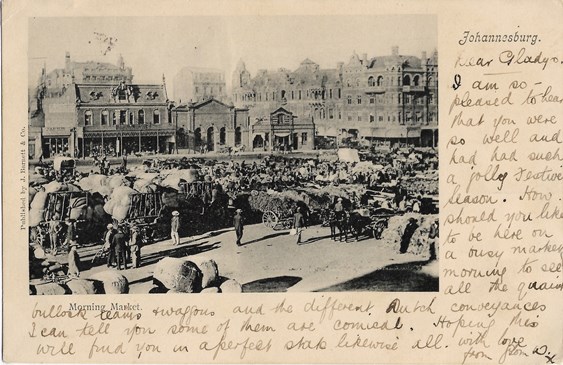TRANSVAAL PICTURE POSTCARD MESSAGES
MARKET SQUARE, JOHANNESBURG
Introduction
President Paul Kruger, first visit to Johannesburg, took place during February 1887 the year the official market was opened on Market Square.
The four streets which surround the Square are as follows:
To the north, President Street,
To the east, Rissik Street,
To the south, Market Street,
To the west, Harrison Street.
While Loveday Street ran from north to south through the middle of the Square.
South side of the Square circa 1888
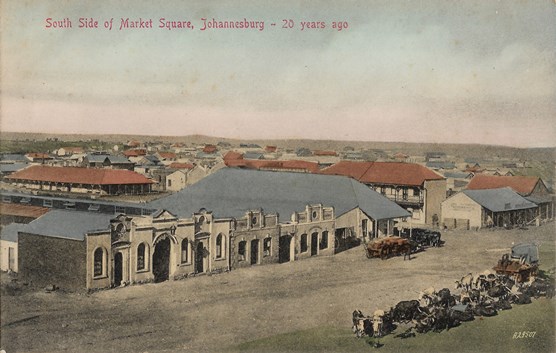
The Postcard
Published by Sallo Epstein & Co., Durban, as card number 2312 and captioned in red, ‘South Side of Market Square, Johannesburg – 20 years ago’. The divided back (address side) is printed in green and was ‘Phototyped in Dresden'.
The Picture
The building featured in this picture was there in 1888 and is one of the first important looking, classical buildings. Moreover, in 1888 most of the buildings in Johannesburg were built of wood and iron and had a deep ‘stoep’ (verandah) so that customers were sheltered from the sunshine. This was particularly significant on the south side of the Square.
The message
"… To judge from this card & to see Joh – burg now you would not think it was the same place, these small shows are all done way with in their place are some very nice buildings
Such a lot of families are leaving E. London some are bound for Australia and others for Joh-burg. There is not sufficient work here. Times are really hard there are heaps of houses vacant. I think it is very bad all over the colony just now – E. London is a difficult place now to what it was before the war…"
Note
This message is from a person who until recently must have been residing in East London, Cape Colony, and had not long been in Johannesburg. There is no date given for the message, but it must be circa 1909.
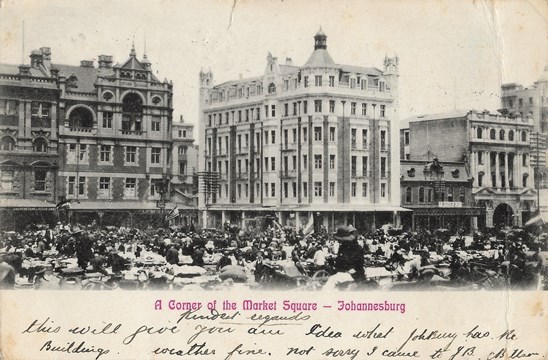
The buildings
The view of Market Square, displays some impressive buildings. From left to right: Loenenstein Building, where the ground floor was occupied by ‘Sanderson Saddlery and Harness’ store, and on the corner of Market and Loveday Streets is Steytler Building, designed in 1896. On the opposite corner is Sauer Building, the next two storey building with dormers in the roof, is Birch Building, the sign reads ‘T. BIRCH & Co. OUTFITTERS’, and the classical style building with projecting pediments over the doors, is the 1891, Natal Bank by M.B. Hauge.
The caption reads: 'A Corner of the Market Square – Johannesburg’, however, it is not strictly on a corner of Market Square. It actually shows the corner of Loveday Street which runs north to south through the middle of the market.
Note
As with the postcard above, the message is from a person, who until recently (the day before!?) had been residing in East London.
The message
[On the address side.] “Met Mr. Rowe he is looking well in fact I have met many old friend up here. I have only been here about six hours. this is very promising"
[On the picture side.] "Kindest regards
this will give you an idea what JohBurg has Re Buildings. Weather fine. Not sorry I came to JB. [Signature]”
The Postcard
Captioned 'A Corner of the Market Square – Johannesburg’ in red and published by ‘P. S. & C. – Box 1205 – Cape Town’. The card is number ‘804’.* The address side has a divided back printed in olive green. It entered the post in Johannesburg on the 6th April 1906 and is address to Clevedon Road, East London, Cape Colony.
* P.S. & C., Box 1205, Cape Town. Paul Schaefer & Co., (also Durban PO Box no.294 and Johannesburg P.O. Box no.1470).
Market Square with the General Post Office to the left.
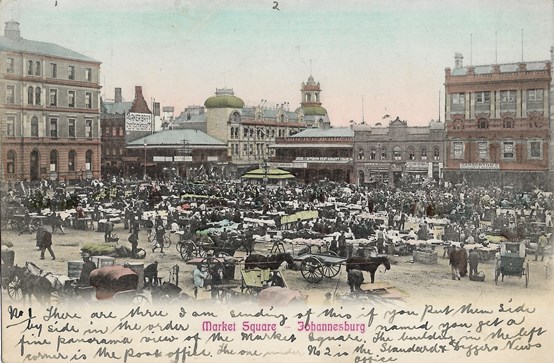
The postcard
Captioned 'Market Square – Johannesburg’ in red, this picture postcard was one of three, posted in an envelope, circa 1905 and before the trams were electrified in 1906, to show a panoramic view of Market Square. The writer has placed two numerals at the top of the picture to indicate the names of the buildings. The address side has a divided back printed in green and published by ‘P. S. & C. – Box 1205 – Cape Town’. The card is number ‘976’. (P.S. & C., were Paul Schaefer & Co., who also published picture postcards at Durban, Box No. 294 and Johannesburg, Box No.1470.)
The message
“No 1. There are three I am sending of this if you put them side by side in the order named you get a fine panorama view of the Market Square. The building in the left corner is the Post Office. The one under No.2 is the Standard & Diggers News office.”
Note
In 1888 the eastern side of the Square, Rissik Street, was initially limited for commercial and administrative purposes.
Postscript
All I have to do now is to find the other two postcards!
Market Square from the same writer (Looking south)
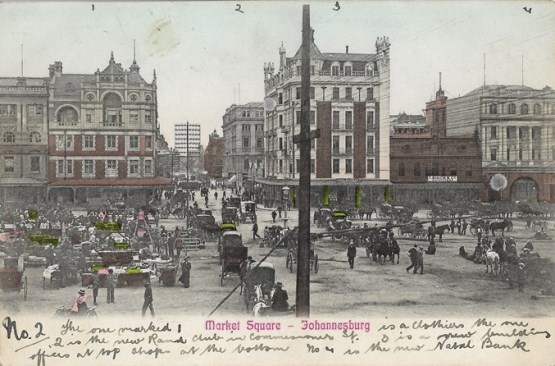
The Message
This is card number ‘2’ of a serial message:
" 1 2 3 4
No. 2 The one marked 1 is a clothiers the one 2 is the new Rand Club in Commissioner St. 3 is a new building office at top shops at the bottom. No. 4 is the new Natal Bank”
Note
This picture postcard is another from the same person as the card above. However, we cannot be sure if this was posted at the same time, or was the first part of a different serial message. As both cards were issued by the same publisher, the writer may have purchased a full set of cards – say six. In that case the lucky addressee could see and read about many of the buildings seen from Market Square.
It is frustrating to see sets of serial card messages split up by postcard dealers. On three occasions I have seen full sets of 'rare' and early cards sold as single cards for small sums of money. However, sold together they would have fetched a four figure sum. The last was on eBay during 2019, when five 'rare' and early cards sold to different collectors / dealers for around £35 each. The vender was probably pleased, but a bit of South African social history was lost. Moreover, without knowing it, he / she was almost a thousand GB pounds short.
The Postcard
Captioned Market Square – Johannesburg’ in red and published by ‘P. S. & C. – Box 1205 – Cape Town’. The card is number ‘977’ and the address side has a divided back printed in olive green.
Postscript
This view is from Market Square and is looking south along Loveday Street. The new five storey Rand Club building, in the Edwardian, Baroque Revival style can be seen on the corner of Loveday and Commissioner Streets. As with most building in the city the ground floor was given over for shops.
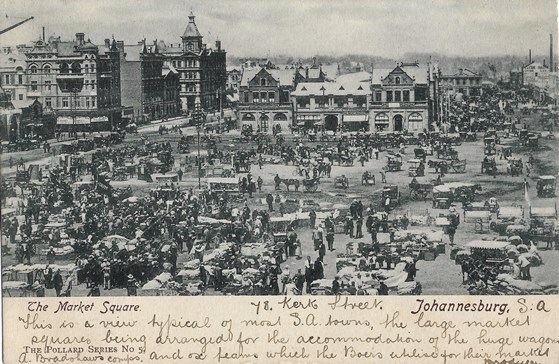
Looking south west.
The message
“78. Kerk Street. [Johannesburg] S.A
This is a view typical of most S.A. towns, the large market squares being arranged for the accommodation of the huge wagons and ox teams which the Boers utilise for their market produce.
A. Bradshaws comps.”
Note
The Square was indeed large. ... yards.
The Postcard
The postcard is part of 'The Pollard Series', No.5 with caption printed in brown and reading The Market Square. Johannesburg. The divided back, address side is also printed in brown and it entered the post on the 14th November 1904 at 2.30pm. It is date stamped with a fine machine cancel and addressed to "Mr. Geo. Longstaff, School Attendance Office, York, England."
Morning Market
